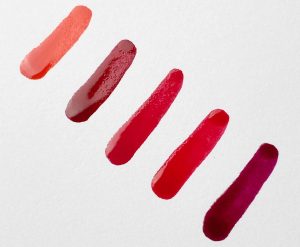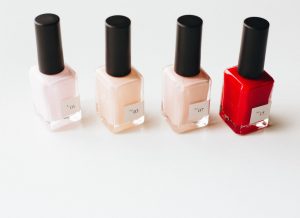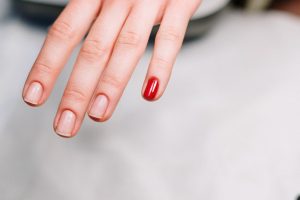You’ve found our post detailing the difference between gel and regular nail polish.
When it comes to manicures, the choice between gel and regular nail polish is one that many ponder. Both options have their own set of advantages and drawbacks, catering to different needs and preferences. Let’s explore the key differences between gel and regular nail polish to help you decide which type of polish is right for you.
Interested in more nail care tips? Check out Tips for Keeping Nails Healthy for Gel Polish Lovers.
This article includes:
- Gel vs regular nail polish
- Is regular polish healthier than gel?
- What are the cons of gel nail polish?
- Regular polish dry time
- Healthiest nail polish option
Let’s get to it!
What’s the Difference Between Gel and Regular Nail Polish?
1. Application Process
Regular Nail Polish
Regular nail polish is applied in a straightforward process. It typically involves a base coat, two to three layers of color, and a top coat. Each layer needs to dry before applying the next, and drying time can vary depending on the polish and environmental conditions. This process usually takes about 30 to 60 minutes to complete fully.
Gel Nail Polish
Gel nail polish requires a more specialized application process. After applying a base coat, gel polish is painted on in layers, with each layer being cured under a UV or LED lamp for 30 to 60 seconds. This curing process hardens the polish almost instantly, allowing you to move on to the next step without waiting for each layer to air-dry. The entire process, including curing, typically takes 45 minutes to an hour.
Learn more about sundays studios’ non-toxic gel and regular polish services.
2. Durability and Longevity
Regular Nail Polish
Regular nail polish lasts about 3 to 7 days before showing signs of chipping or wear. Its durability can be influenced by factors such as the quality of the polish, your daily activities, and how well you apply and maintain the manicure.
Gel Nail Polish
Gel nail polish is known for its exceptional durability, lasting up to 2 to 3 weeks without chipping or fading. The curing process creates a hard, protective layer that withstands daily wear and tear better than regular polish. This makes gel polish a popular choice for those seeking long-lasting manicures.
Learn more about Which Lasts Longer: Gel Or Regular Nail Polish?.
3. Removal Process
Regular Nail Polish
Removing regular nail polish is simple and quick. You can use regular nail polish remover, acetone or non-acetone, and a cotton pad to wipe away the polish. The process takes just a few minutes and doesn’t require any special tools or techniques.
Gel Nail Polish
Removing gel nail polish is more involved and time-consuming. It requires soaking your nails in acetone or using acetone-soaked cotton pads wrapped in foil for 10 to 15 minutes. After soaking, gently scrape off the softened gel polish with a cuticle pusher or an orange stick. Improper removal can damage your natural nails, so it’s important to follow the correct steps or have it done by a professional.
Learn more about Dermatologist’s secret for removing gel nail polish at home.
4. Finish and Appearance
Regular Nail Polish
Regular nail polish offers a wide range of colors and finishes, including matte, glossy, metallic, and glitter. While the finish can be beautiful, it’s often less shiny and smooth compared to gel polish. The finish may also become duller, especially if you skip using a top coat.
Gel Nail Polish
Gel nail polish provides a high-gloss, salon-quality finish that stays shiny and smooth for the duration of the manicure. The curing process ensures a flawless, chip-free look that can maintain its appearance for weeks. Gel polish also offers a variety of colors and finishes, though the selection might be slightly less extensive than regular polish.
Learn more about Gel Manicures: The Benefits, Cost, and How Long They Last.
5. Health Considerations
Regular Nail Polish
Regular nail polish is generally considered safe for most people, though some formulas contain chemicals like formaldehyde, toluene, and dibutyl phthalate (DBP), which can be harmful. Many brands now offer 3-free, 5-free, or even 10-free formulas that exclude these harmful chemicals, making them safer for regular use.
Gel Nail Polish
Gel nail polish involves exposure to UV or LED light for curing, which raises some health concerns. Prolonged exposure to UV light can increase the risk of skin damage and aging. Using sunscreen on your hands or opting for LED lamps, which emit less UV light, can mitigate this risk. Additionally, frequent use of acetone for removal can be drying to the nails and skin.
Learn more about Side effects of gel nail polish: A systematic review.
Final Thoughts
Choosing between gel and regular nail polish depends on your lifestyle, preferences, and the occasion. Regular nail polish is great for quick changes and for those who prefer a simple, straightforward application and removal process. Gel polish, with its long-lasting durability and high-gloss finish, is ideal for those seeking a manicure that can withstand daily wear and tear for weeks. By understanding the differences between the two, you can make an informed decision that best suits your nail care needs.
Next, check out Tips for Keeping Nails Healthy for Gel Polish Lovers.







